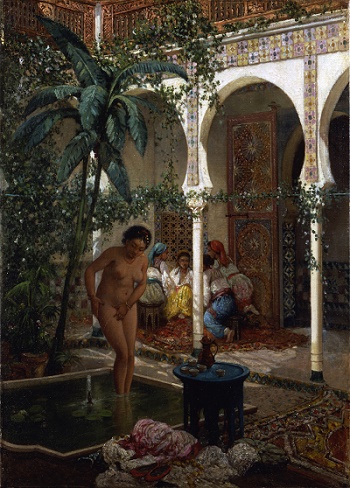Mac-Alfred Chataud (French, 1833–1908)
Women of the Harem at the Poolside
Oil on Canvas, 21 1/2 x 15 1/2 in.
Signed lower right: A. Chataud
1995.52

Although Mac-Alfred Chataud painted French landscapes, he is best known for his paintings of Algeria, his principal submissions to the Paris Salon. His father was a banker, and expected his son to enter into the business world. Chataud thus began his career working for an insurance company in Paris, until he gave up his practical employment in 1857, and moved back home to Marseilles in Southern France to study art. Chataud’s family owned property in Algeria, and he made several short visits to North Africa (visiting Tunisia and Morocco as well) between 1856 and 1892, when he permanently settled in Algeria. He became an important figure in the Algerian art scene, helping to found the Society of Algerian Artists in 1897, and serving as that organization’s vice president in 1904.
Chataud’s Women of the Harem at the Poolside was likely painted earlier in the artist’s career, before he moved to Algeria and concentrated on recording scenes of daily life and the old quarters of the cities of Algiers and Tlemcen. Women of the Harem at the Poolside is typical of Chataud’s initial imaginative scenes and reflects the influence of well-known Orientalist artists like Eugène Delacroix and Henri Regnault—rather than actual exposure to the culture. This image depicts the fantasy of the harem, which the West found more entrancing than any other aspect of North African life. As a secluded space for female family members in an Islamic household, Westerners—especially men—were never permitted to enter harems. This exclusion added to the harem’s mythology as a space containing languid women waiting to satisfy the pleasures of the male head of household. The bathing figure in the middle-ground of the image, whose nudity contrasts starkly with the group of four women in the background, conveys the sensual, erotic tones that typify many imaginary Western harem scenes. All five women are represented within an exotic, non-Western setting of Islamic architectural features —horseshoe arches, ornamental grating, and striking tile work—filled with palm trees, Turkish carpets, and a coffee service.


